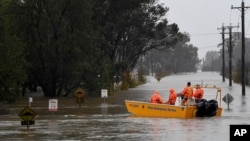Rescue training for residents, including children, is among key recommendations of an independent inquiry into devastating floods this year in Australia.
The report, commissioned by the New South Wales state government, also said residents in the “highest-risk” areas near the city of Lismore should be relocated "urgently."
Also among the inquiry's 28 recommendations were a state buyback of flood-prone properties and land swaps to enable property owners to move to higher ground.
Mary O’Kane, a former Australian chief scientist, co-authored the report. She told the Australian Broadcasting Corp. that flood-prone communities had to be better protected.
"We are also recommending that that we make sure with floods, people are out of harm’s way as much as possible," O'Kane said. "Floods are a predictable disaster in the sense we know where they will happen. They will happen in floodplains, and we need to make sure that people are not living in the direct line of the water.”
The New South Wales government has promised to implement all 28 recommendations. State Premier Dominic Perrottet, said, "The way that we approach this will take time, but it will ensure that our strong communities build back in a stronger and more resilient way.”
Authorities in New South Wales, Australia’s most populous state, will overhaul the way natural disasters are handled. The administrations of the Rural Fire Service and the State Emergency Service, which are mostly volunteer organizations, will be merged. A permanent reconstruction and disaster prevention agency also will be set up.
Residents in flood-hit areas had said the emergency response to this year’s flooding by government agencies and councils was too slow and incomplete.
In Lismore, residents took to the flooded city streets in a so-called tinnie army — a makeshift flotilla of private boats and personal watercraft — to rescue stranded residents because the official response was too slow.
The report also called for new methods to understand the risks of climate change and extreme rainfall.
Australia's Bureau of Meteorology said this year’s record-breaking floods were caused by a La Nina weather pattern that could well have been made worse by global warming.





